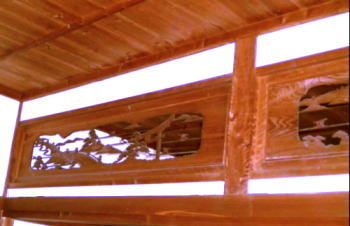Last update June 8, 2021
観光用語解説
欄間 (らんま)

 お年寄りのなかには、床の間や欄間のない家は家じゃないなんて言う人もいるんだけど、やっぱりさあ、そりゃ、日本人の家らしいわよね、あったほうが。
お年寄りのなかには、床の間や欄間のない家は家じゃないなんて言う人もいるんだけど、やっぱりさあ、そりゃ、日本人の家らしいわよね、あったほうが。
 写真のような凝ったものもあるわよ。その他、富士山とか鶴亀とかめでたいモチーフなんかもね。で、欄間の起源というのは、平安時代。当時は、灯り取りが目的だったらしくて、模様も単純な縦横の格子だとかが使われてたんだって。それが、鎌倉時代になると、透かし彫りとか彫刻とかね、装飾が施されるようになったのね。桃山時代になるとますます豪華絢爛になってきちゃって、江戸時代初期にはピークだったらしいわ。
写真のような凝ったものもあるわよ。その他、富士山とか鶴亀とかめでたいモチーフなんかもね。で、欄間の起源というのは、平安時代。当時は、灯り取りが目的だったらしくて、模様も単純な縦横の格子だとかが使われてたんだって。それが、鎌倉時代になると、透かし彫りとか彫刻とかね、装飾が施されるようになったのね。桃山時代になるとますます豪華絢爛になってきちゃって、江戸時代初期にはピークだったらしいわ。
Ranma (Decorative Transom)
 Ranma or a decorative transom dates back to the Heian Period (794 - 1192). With the purpose of letting light in, its decorative aspect was not important in those days, therefore, simple patterns such as a lattice were mostly used.
Ranma or a decorative transom dates back to the Heian Period (794 - 1192). With the purpose of letting light in, its decorative aspect was not important in those days, therefore, simple patterns such as a lattice were mostly used.
 Since the Kamakura Period (1192 - 1333), people came to focus on the ornamental aspect, and in the Momoyama Period (1573 - 1600), the Ranma began to incorporate even more laborious decorations. In the Edo Period (1603 - 1867), the level of elaboration reached its peak: lavishing techniques of intricated sculpture and openwork, architects created heavily-decorated, glamorous items. Thus, the Ranma gradually began to lose its original function.
Since the Kamakura Period (1192 - 1333), people came to focus on the ornamental aspect, and in the Momoyama Period (1573 - 1600), the Ranma began to incorporate even more laborious decorations. In the Edo Period (1603 - 1867), the level of elaboration reached its peak: lavishing techniques of intricated sculpture and openwork, architects created heavily-decorated, glamorous items. Thus, the Ranma gradually began to lose its original function.



 お年寄りのなかには、床の間や欄間のない家は家じゃないなんて言う人もいるんだけど、やっぱりさあ、そりゃ、日本人の家らしいわよね、あったほうが。
お年寄りのなかには、床の間や欄間のない家は家じゃないなんて言う人もいるんだけど、やっぱりさあ、そりゃ、日本人の家らしいわよね、あったほうが。 写真のような凝ったものもあるわよ。その他、富士山とか鶴亀とかめでたいモチーフなんかもね。で、欄間の起源というのは、平安時代。当時は、灯り取りが目的だったらしくて、模様も単純な縦横の格子だとかが使われてたんだって。それが、鎌倉時代になると、透かし彫りとか彫刻とかね、装飾が施されるようになったのね。桃山時代になるとますます豪華絢爛になってきちゃって、江戸時代初期にはピークだったらしいわ。
写真のような凝ったものもあるわよ。その他、富士山とか鶴亀とかめでたいモチーフなんかもね。で、欄間の起源というのは、平安時代。当時は、灯り取りが目的だったらしくて、模様も単純な縦横の格子だとかが使われてたんだって。それが、鎌倉時代になると、透かし彫りとか彫刻とかね、装飾が施されるようになったのね。桃山時代になるとますます豪華絢爛になってきちゃって、江戸時代初期にはピークだったらしいわ。
 Since the
Since the